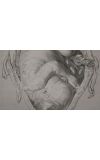
03 Jul 2012 11:22:09
Thought the conditions under which women gave birth in the 1950s, laid out in Call the Midwife, were harrowing? Try the 17th century, when with much "strugling [sic], halings, and enforcements" midwifes would attempt to pull babies out before labour had even begun, and a hooked stick, or "crotchet", was used in the place of forceps.
Percival Willughby practised as an obstetrician from around 1630, and recorded more than 200 cases in his Observations in Midwifery, a work written around 1670 in which he intended "to inform the ignorant common midwives with such wayes as I have used with good successe ... shewing the wayes how to deliver any difficult birth, bee it naturall, or, unnaturall". Just two complete copies of the 600-plus page manuscript remain today, one of which is set to go up for auction next month.
"It's incredibly rare," said Chris Albury, of the Dominic Winter auction house in Cirencester. "And it's a fantastic piece of work. It's just so charming, the handwriting is so legible and the language so fresh. You really feel a genuine warmth to this person. It's not just of medical interest – it's an insight into 17th-century society, in that it gives details of these families and homes he is visiting, and their circumstances. You really get a whole flavour of the period from this one perspective."
Willughby, who wanted to remedy the brutal methods often used by the midwifes of the time, goes into great and gory detail in many of his cases, including that of one woman who suffers a lapsed uterus and "being troubled, and discontented, and wearied with this affliction, in hopes to cure her serf, shee went into the garden, and, laying hold on it, drew it, and cut it forth". He also records the first description of an obstetric manoeuvre in which the neck of the womb is cut on both sides with a knife. It "proved gristly in cutting", but "the passage being thus opened – the woman was happily delivered of a living child".
"Obviously, it's quite sad a lot of the time as inevitably a lot of deaths occur," said Albury. "It's very gruesome, too – there's no anaesthetic and no real tools, as forceps weren't known about, so their main tool was a crotchet, a hooked stick. But Willughby is very much a hands-off, non-interventionist midwife – he's very modern in that sense."
Willughby's kindly, reassuring manner meant his clientele ranged from the gentry to the poor. His approach often appears ahead of his time: he recalls a case in Chesterfield in 1646 when "Dorothy North, wife to Gilbert, being great with child, was afflicted with some disquiets in her belly". Several midwives were called to attend her – "one of them thrust up her hand, and made great struggling in her body; at the taking of it forth, her hand was all over bloody, and this midwife made great vaunts of her skil, and doings, and said that the child did stick to the woman's back, but that shee had removed it".
When Willughby arrived, he "found that the waters had not flowed, and that the womb was closed", so he advised patience, and that "the fruit would fall off it-self, when that it was full ripe". Three days later, the woman delivered a child, but it was dead.
"I should bee troubled to heare any midwife affirme, that a child did, or could, stick to the back, or side, of the mother. It would argue and shew a grosse ignorance in such a midwife," wrote Willughby. The child "is inclosed within the membranes in the womb, and that it there swimmeth in water, and that the womb doth not stick to the back, or side, much lesse the child, swimming in water, and inclosed in severall coates, containing or holding in, these waters in the womb. And that they cannot help any woman before the womb doth open, and that, in part, some of the waters have issued."
He advises women against taking a midwife who "will pull, stretch, or hale their bodies, or use any violence to enforce the womb, in hopes of a speedier delivery. Such struglings and doings make a difficult, painfull, and long labour."
Dominic Winter is putting a guide price of £20,000 to £30,000 on the manuscript, which is part of an auction of the Birmingham Medical Institute's antiquarian library on 26 July, along with around 400 lots of printed medical books, manuscripts, and bound volumes of pamphlets and pictures.
The only other complete copy of Willughby's work is in the Royal Society of Medicine, with a partial version in the British library. Strangely, the work was not published in Willughby's lifetime, and in fact did not get published until 1863. Then just 100 copies were produced, only 17 of which sold, making it even rarer.
"It's a bit of a mystery why it wasn't published – whether he felt it wasn't worthy, perhaps," said Albury. "But it is a mystery, because clearly he wanted to help as many people as possible. Certainly today, I imagine anyone with an interest in obstetrics and gynaecology will be fascinated – it's a gripping read, a bit morbid, but a real page-turner."

